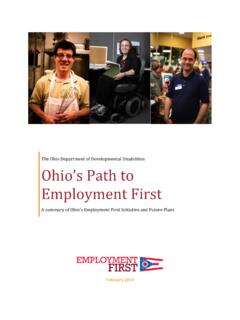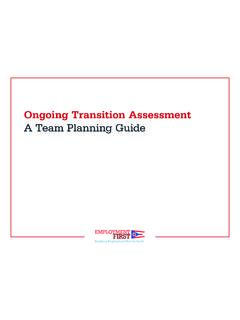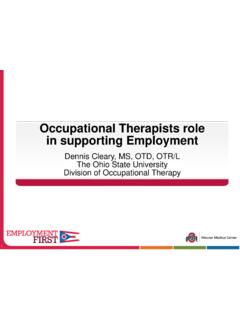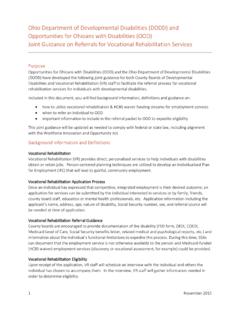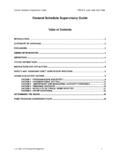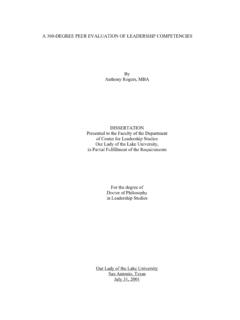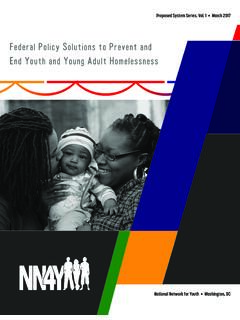Transcription of The Job Matching Process - ohioemploymentfirst.org
1 The Job Matching Process Andrew Persch, PhD, OTR/L. Division of Occupational Therapy The Ohio State University April 28, 2015. 1. Month Trainings available @ website June 30, 2014 Task analysis for job coaches July 21, 2014 Worksite Analysis for job coaches August 28, 2014 Tablet Computers and Smartphones as workplace supports September 23, 2014 The Role of the Occupational Therapist in supporting employment October 27, 2014 The Role of Rehab Engineering and the Assistive Technology Center in supporting employment November 20, 2014 Video Resumes and Professional Portfolios: Presenting Job Seekers in the best light January 26, 2015 Augmentative Communication Devices as employment supports. February 26, 2015 Employment supports for those with IDD and Autism. March 16, 2015 Employment supports for those with Physical or Sensory involvement. April 28, 2015 The Job Matching Process 2. 3. Objectives 1. Examine the job Matching Process from the perspectives of the client, job coach, employer, job developer, and VR.
2 Professional 2. Review the kinds of supports that are available to help streamline the job Matching Process 3. Demonstrate how to use a systematic job Matching Process 4. Present best practices in job Matching 4. Background About 3% (9 million people) of the American population lives with an intellectual disability (ID)1. Birth 21, IDEA. Postsecondary Intellectual All General Outcomes Disabilities Disabilities Population Education 29% 60% 67%. Employment 39% 60% 66%. 2. Total lifetime costs (healthcare, support services, lost productivity) $1 million per individual with ID3. 1 Administration on Intellectual and Developmental Disabilities, 2012. 2 Newman et al., 2011; Bureau of Labor Statistics, 2012. 3 Centers for Disease Control and Prevention, 2006. Importance of Employment Work is a fundamental human occupation Strongly linked to identity1,SES,2 QoL,3 and health4. Provides sociocognitive structure to view the world5.
3 Federal contractors must employ 7%6. Most employment services fail to meet the needs of those in transition7. 1 Corcoran, 2004 7 Wehman, 2006; Wehman & Scott, 2013. 2 Butterworth et al., 2012. 3 Eggleton et al., 1999. 4 Petrovski & Gleeson, 1997. 5 Daston, Riehle, & Rutkowski, 2012. 6 Final Rule on Section 503 of the Rehabilitation Act of 1973. Integrated Reasonable Accommodations . Project SEARCH . Environment Customized Employment Supported Employment Segregated Sheltered Workshops High Level of Support Low Research Program Current Practices in Job Matching Vocational Fit Assessment Study #1 Research Questions 1. What are the current practices in job Matching ? 2. What are the outcomes of JM/JP practices? 3. What tools do professionals use to inform JM/JP. decisions? Phase Product Mixed-Methods Sequential Explanatory Design Procedure Web-based cross- Numeric data QUANTITATIVE and sectional survey Narrative data Narrative data Collection (N = 192).
4 data screening and Descriptive QUANTITATIVE data cleaning statistics Analysis Univariate analyses Frequencies Purposefully selected Focus groups Focus Group key stakeholders (k = 4). Development Develop focus group Focus group protocol protocol Focus groups Textual data Qualitative data Collection conducted with 4 key transcribed from stakeholder groups focus group Audio-video recording recordings Triangulation of observers Coding Codes and themes Qualitative data Analysis Case comparison Thematic structure Thematic analysis Constant comparison Integration of Interpretation and Development of Quantitative and explanation of visual model Qualitative Findings quantitative and Discussion qualitative findings Implications Survey Participants N = 192; response rate 97% aged 25-65. 90% White, 7% Black, 2% Hispanic 84% Female; 16% Male Years of experience = , = Place of Employment Participant Identification Focus Group (k=4) Participants Professionals (n=7) 5 women; 36-64; all White Proportion Proportion College students (n=6) all men; 18-24; all White High-school students #1 (n=5) 4 women; 18-24; 1 Black, 1.
5 Hispanic, 3 White 0. 0. High-school students #2 (n=2) 2 men; 18-24; 1 Black, 1. White Study #1 Integrated Findings Job Matching is a Collaborative Process Stakeholders Involved in Job Matching Percentage Stakeholder Group Study #1 Integrated Findings Job Matching is a Collaborative Process meeting is held with the intern's team to include [sic] the Project SEARCH team, relatives, friends and supportive people in the intern's life.. In my opinion the Process that works best is what works best for the individual and that is usually a team approach that includes the job seeker, family members, friends, community folks, including employers and the providers that know the job seeker well and can provide input.. Study #1 Integrated Findings Key Stakeholders Consider Many Types of data When Job Matching Types of data that Inform Job Matching Proportion 0. Psychological IEP FBA Behavioral Task Analyses Interest Job Descriptions Matching Tool Reports Assessment Inventories data Type Study #1 Integrated Findings Key Stakeholders Consider Many Types of data When Job Matching Job training evaluations, feedback from managers, coworkers, and parents to have a comprehensive understanding of the individual's skills in order to match the person with a disability to a particular job, work evaluations, assessment of transferrable skills level of independence, mode of transportation, willingness to work part-time or full-time, and level of motivation.
6 Study #1 Integrated Findings Current Practices in Job Matching are Variable and Lack Consistency Consistency of Job Matching Practices Proportion 0. 1 2 3 4 5 6 7 8 9 10. Consistency (1=not consistent; 10=very consistent). Study #1 Integrated Findings Current Practices in Job Matching are Variable and Lack Consistency trial and error is used most often! Job developers try their best to find open positions that might match a person's interest and skill set and hope that the team agrees.. We use discovery first to get to know the individual job seeker. We then use warm contacts, cold contacts and the job bank to search for appropriate positions. We offer a Summer Program to high school students to expose them to work. We offer Project SEARCH! . Study #1 Integrated Findings Outcomes of the Job Matching Process are Poorly Defined community employment . We have great outcomes. At least 60% each year with some sites getting 100%.
7 Of those employed there is a high percentage of long term stability, on the average, we have been over 80% successful, 85% hire rate long term, about 80% retentions [sic] rate.. Study #1 Integrated Findings Outcomes of the Job Matching Process are Poorly Defined This Process has equipped students with the job readiness skills need [sic] to successfully and actively pursue employment opportunity [sic] after post-secondary completion.. individuals have learned employability skills.. help them get a work placement that they like and can learn several skills that can be generalized to future employment.. Study #1 Discussion In the absence of adequate job Matching resources, we strongly recommend that transition teams employ best practices including: a) proactive interdisciplinary and interagency teaming, collaboration, and community outreach b) data -based decision making c) defining acceptable, person-centered outcomes d) working to increase the consistency of transition planning practices.
8 Study #1 Discussion Job Matching is the collaborative, data -based decision- making Process used by transition teams to determine the best fit between an individual's abilities and preferences and the job's environmental and occupational demands.. A systematic procedure for making job Matching decisions is needed to decrease the variability of job Matching practices may be capable of enhancing outcomes. Limitations include descriptive statistics that limit inference and few key stakeholder perspectives. 1 Persch, Cleary, Rutkowski, Malone, Darragh, & Case-Smith, 2015. Defining the Domain Work of People Where do youth & young adults With with disabilities work? Disabilities National Longitudinal Transition Study 2 (NLTS2). Categories of Jobs Retail Clerical Trades Food Service Custodial Manufacturing 412 Retail Sales Workers O*Net provides comprehensive information on key characteristics of workers and occupations.
9 Harvested O*Net identified task and work context items = 2,970 items 100. 1,000. Items Items 2,970. Items Study #2 Findings 126 VFA Common Item Stems Communication Skills (k=6). Example Cognitive ExampleExample Abilities Cognitive Communication ExampleSubscale Abilities Items Skills Higher Subscale Subscale T-R Items Items Items Abilities Subscale Interpersonal Skills (k=6). Higher Task-Related Abilities (k=8). Lower Task-Related Abilities (k=8). Cognitive Abilities (k=7). ability toability count, toweigh, ability to measure, communicateprint ato ability file/. or organize document face-to-face deliver materials with others completed work Work Structure (k=7). ability toability sort, assemble, toability toability and work withreplyproof to an external completed email stock message customers work or the or restock public supplies Safety (k=7). Physical Abilities (k=10). Self-Determination (k=11). ability toability be very toability exact/ tovery deal with navigate accurate conflict ability to a to set upspecific web machines and adjust address 126 items 10 subscales, 86 items Computer Skills (k=16).
10 Study #2 Findings VFA-W Ordinal VFA-J. Cognitive Abilities (k=7) Communication Skills (k=6) Computer Skills (k=16) Higher Task-Related Abilities (k=8) Interpersonal Skills (k=6) Lower Task-Related Abilities (k=8) Physical Abilities (k=10) Safety (k=7) Self-Determination (k=11) Work Structure (k=7) Novel Approach to Job Matching Systematic data driven Analytical Instructional Prompt + Common Item Stem + Customized Rating Scale VFA Worker To what degree does the worker demonstrate the ability to communicate face-to-face with other people? High Ability Some Ability Low Ability VFA Job To what degree does the job demand the ability to communicate face-to-face with other people? High Demand Some Demand Low Demand Vocational Fit Assessment (VFA). 4+ yr. - iterative, instrument development Process 70% of individuals with disabilities = 153 jobs 153 jobs = 2,970 work tasks ( , items). 18 months, item optimization Resulted in 126 item assessment Items reflect the work of people with disabilities Purposes of the VFA: a) assess individual abilities b) assess job demands c) identify pros and cons of each potential job match d) identify areas of need, suitable for intervention How does this work?
